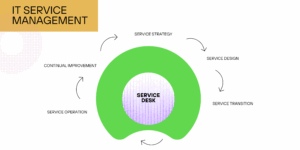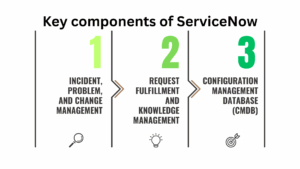In today’s fast-paced digital world, efficiency is key. IT service management (ITSM) plays a crucial role in achieving this. ServiceNow ITSM stands out as a leading platform in this domain. It offers a comprehensive suite of tools designed to streamline IT operations. Organizations can enhance service delivery and user experience with its features.
ServiceNow ITSM integrates seamlessly with other systems, promoting a unified approach. Automation of routine tasks reduces manual effort and errors. Real-time analytics enable data-driven decision-making. The platform supports ITIL best practices, ensuring industry alignment.
ServiceNow ITSM is highly customizable, catering to specific organizational needs. Its mobile capabilities allow IT teams to manage services on-the-go. The platform’s AI features enhance predictive analytics and problem-solving. Implementing ServiceNow ITSM can lead to reduced downtime and improved customer satisfaction.

IT Service Management (ITSM) encompasses all activities related to designing, creating, delivering, and managing IT services. It aims to align IT services with business needs, improving efficiency and service quality. At its core, ITSM focuses on continuous process improvement.
ITSM tools play a critical role in facilitating these processes. They help organizations manage incidents, changes, and problems effectively. These tools support service delivery through automation and standardization. They offer a framework for handling IT services in a structured manner.

Key benefits of using ITSM tools include:
ServiceNow ITSM is a leader in this field, offering extensive features and flexibility. It supports ITIL best practices, ensuring organizations stay aligned with industry standards. The platform also integrates well with other systems, expanding its functionality further.
ServiceNow ITSM is a comprehensive platform for managing IT services across organizations. It is designed to streamline IT operations while enhancing service quality and user experiences. This platform integrates various processes, ensuring seamless operations.
At its core, ServiceNow ITSM provides a centralized hub for all IT service activities. It enables organizations to track incidents, manage changes, and resolve problems efficiently. Its user-friendly interface simplifies navigation and boosts productivity.

Key components of ServiceNow ITSM include:
The platform incorporates ITIL best practices, aligning IT services with business objectives. ServiceNow ITSM is scalable and customizable, fitting the needs of both small businesses and large enterprises. Its ability to integrate with other systems further enhances its functionality, making it a vital tool for modern IT service management.
ServiceNow ITSM offers a suite of features designed to optimize IT service management. These tools improve both efficiency and quality of service. It encompasses essential processes that are crucial for modern IT operations.
One of the standout features is incident management, which allows for quick identification and resolution of issues. This helps reduce downtime and enhances service reliability. Problem management adds another layer by addressing root causes.
Change and release management is integral in minimizing risks associated with IT changes. It ensures smooth transitions and aligns with organizational goals. ServiceNow also excels in request and knowledge management, streamlining request handling and information accessibility.
A key component is the Configuration Management Database (CMDB), which provides an overview of IT assets and their relationships. This database supports informed decision-making. Users benefit from automation and AI capabilities integrated across the platform.
ServiceNow ITSM also supports:
The platform’s scalable nature makes it adaptable to various organizational sizes and structures. Its integration capabilities extend functionality, offering a comprehensive service management experience.
ServiceNow’s incident management feature focuses on effective issue resolution. It prioritizes incidents based on impact. This ensures critical issues are addressed promptly.
Key elements include:
This system improves response times and reduces service disruptions. Employees and customers experience enhanced service delivery.
Problem management in ServiceNow ITSM identifies and resolves root causes of recurring issues. It prevents the reoccurrence of incidents. This process enhances overall service stability.
Core activities involve:
This proactive approach not only resolves current problems but also anticipates future issues. This strategy contributes to long-term service reliability.
ServiceNow provides robust change and release management features. These minimize disruption during IT changes. By tracking changes, organizations manage risks effectively.
Main components include:
These tools ensure smooth implementation of updates and new services. Organizations can control their IT landscapes better with these capabilities.
ServiceNow streamlines request management and knowledge sharing. Request management handles service requests efficiently. It reduces bottlenecks and enhances service speed.
Features include:
The knowledge management feature centralizes valuable information. It empowers users and IT staff with accessible resources.
The CMDB in ServiceNow offers a comprehensive view of IT resources. It captures details about configurations, dependencies, and relationships. This supports informed decisions.
Its capabilities include:
Organizations benefit from better resource management and strategic planning with a centralized database.
ServiceNow ITSM is not just about managing incidents but also about leveraging technology to drive efficiency. Automation plays a crucial role in this transformation process. Routine tasks that typically consume time and resources are automated, freeing up the IT team to focus on more strategic initiatives.
Key automation capabilities include:
Artificial Intelligence (AI) further enhances the platform by providing predictive capabilities. It anticipates issues before they escalate, improving proactive problem-solving. Machine learning algorithms analyze patterns and suggest optimal resolutions.
AI features include:
Analytics offers real-time insights into IT operations. Managers can leverage these insights to make data-driven decisions. Detailed reports and dashboards help track performance, ensuring IT services align with business needs.
This combination of automation, AI, and analytics transforms IT service management. Organizations experience greater agility, improved service delivery, and a robust approach to managing their IT environments. These capabilities position ServiceNow ITSM as a pivotal tool in modern IT strategy.
ServiceNow ITSM offers numerous benefits that enhance IT operations and overall organizational efficiency. One primary advantage is improved service delivery. It ensures faster incident resolution, which directly impacts user satisfaction.
Organizations also benefit from enhanced collaboration and communication. With a centralized platform, teams across departments can coordinate effectively. This synergy leads to smoother operations and minimizes delays.
Furthermore, ServiceNow ITSM reduces operational costs by automating redundant tasks. Automation cuts down on manual labor, thus allocating resources more efficiently. This results in significant cost savings over time.
Key benefits include:
ServiceNow ITSM aligns IT services with business goals, promoting digital transformation. This alignment ensures that IT solutions are tailored to business needs, fostering innovation and growth. Its scalable infrastructure also supports organizations of all sizes, enabling sustainable expansion and adaptation to changing market demands.
Successful implementation of ServiceNow ITSM requires careful planning and execution. Begin with a comprehensive assessment of your current IT service management landscape. Identify areas needing improvement to tailor the ServiceNow deployment to specific needs.
Engagement with stakeholders at all levels is crucial. Involve IT teams, business leaders, and end-users in the planning phase. Their input and buy-in will facilitate smoother adoption and integration across departments.
Training and support are key components of effective implementation. Ensure thorough training sessions are conducted to familiarize users with the platform. Continuous support should be available to address any challenges and smooth the transition process.
Consider implementing the following best practices:
Regularly review and optimize processes to align with evolving business objectives. ServiceNow ITSM is not a static tool but one that should evolve with organizational needs. By following these best practices, businesses can maximize the value and efficiency derived from their ITSM solutions.
Also consider:
Integrating ServiceNow ITSM with existing ITSM tools and business systems can enhance operational efficiency. Seamless integration ensures that data flows smoothly between systems, facilitating better decision-making. This unified approach helps organizations leverage the full potential of their IT ecosystem.
ServiceNow ITSM supports integration with various third-party applications, enhancing its functionality. This capability allows organizations to create a robust, interconnected network of IT services and business functions. Whether it’s financial systems, HR platforms, or CRM tools, integration broadens the service management horizon.
Consider the following integration benefits:
Strategically integrating ServiceNow ITSM with existing systems not only reduces redundancy but also provides a comprehensive view of IT and business operations. This connectivity is vital for organizations aiming to foster agility and responsiveness in a dynamic business environment.
Organizations across various industries have successfully implemented ServiceNow ITSM to transform their service management processes. These real-world examples highlight the platform’s versatility and effectiveness. By leveraging ServiceNow ITSM, companies have improved service delivery and customer satisfaction.
For instance, a global financial institution adopted ServiceNow ITSM to streamline their incident and change management processes. This integration led to a significant reduction in service downtime and expedited issue resolution. The platform’s automation capabilities allowed their IT teams to focus on strategic initiatives rather than routine tasks.
Key achievements from implementing ServiceNow ITSM include:
Another success story involves a healthcare provider that integrated ServiceNow ITSM with their existing systems. This integration improved data visibility and compliance management. By simplifying workflows, the healthcare provider enhanced patient care while reducing administrative overhead.
Adopting ITSM solutions like ServiceNow can present challenges, especially for organizations lacking experience in service management transitions. Addressing these issues early ensures smoother implementation and greater success. Common hurdles include resistance to change and technology integration difficulties.
To overcome these obstacles, organizations should focus on:
Additionally, leveraging expert guidance can help navigate the complexities of ITSM adoption. Establishing a clear roadmap and incremental goals further facilitates a successful transition. These strategies enhance stakeholder commitment and foster an environment conducive to change, ultimately maximizing ITSM benefits.
As the digital landscape evolves, ServiceNow continues to lead IT service management into the future. With innovations in AI and automation, ServiceNow ITSM sets a new standard. The platform embraces emerging trends, adapting to technological advances with agility and foresight.
Key future trends with ServiceNow include:

ServiceNow’s commitment to continuous improvement ensures its solutions remain relevant and forward-thinking. Their focus on customer needs and market shifts positions ServiceNow ITSM as a pivotal player in digital transformation. Organizations leveraging these advancements will enhance their efficiency and remain competitive in a rapidly changing environment.
ServiceNow ITSM empowers organizations to optimize their IT service management processes effectively. By leveraging its robust features, businesses can enhance efficiency and deliver superior services.
Adopting ServiceNow ITSM facilitates digital transformation, aligning IT operations with strategic goals. This alignment results in improved performance, satisfied customers, and a competitive edge in today’s dynamic landscape.
Answer: ITSM (IT Service Management) tools are software applications designed to support the management of IT services. They facilitate processes like incident management, change management, problem management, and service request handling. These tools enhance operational efficiency by automating tasks, providing insights through analytics, and ensuring alignment between IT services and business needs.
Answer: ServiceNow ITSM improves organizational efficiency through automation of routine tasks, providing real-time analytics for informed decision-making, and integrating seamlessly with other systems. By streamlining processes like incident resolution and change management, it minimizes downtime and enhances service delivery. Its user-friendly interface enables IT teams to work more effectively, ultimately leading to higher customer satisfaction.
Answer: ServiceNow ITSM offers several benefits, including enhanced service delivery, improved collaboration among teams, cost savings through automation, and increased user satisfaction. Its scalability and customization options allow organizations of all sizes to tailor the platform to their specific needs, while its integration capabilities enhance functionality across other business systems.
Answer: Yes, ServiceNow ITSM can integrate with various third-party applications and existing business systems, enhancing its functionality and creating a unified IT ecosystem. This integration enables better data sharing, workflow automation, and improved collaboration across different departments, which can lead to more efficient operations.
Answer: The key components of ServiceNow ITSM include incident management, problem management, change management, request fulfillment, knowledge management, and the configuration management database (CMDB). These components work together to provide a comprehensive framework for managing IT services and ensuring alignment with business objectives.